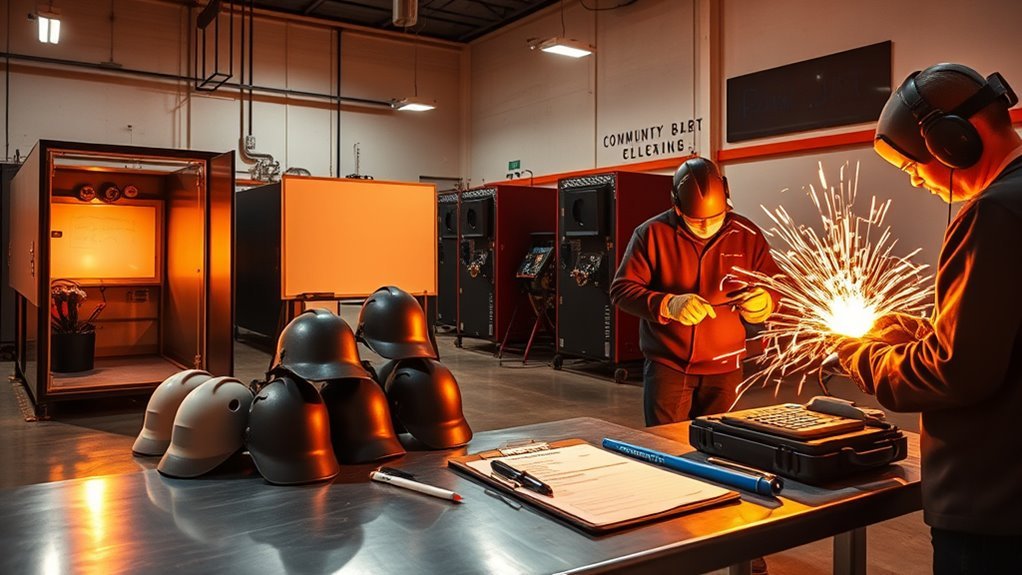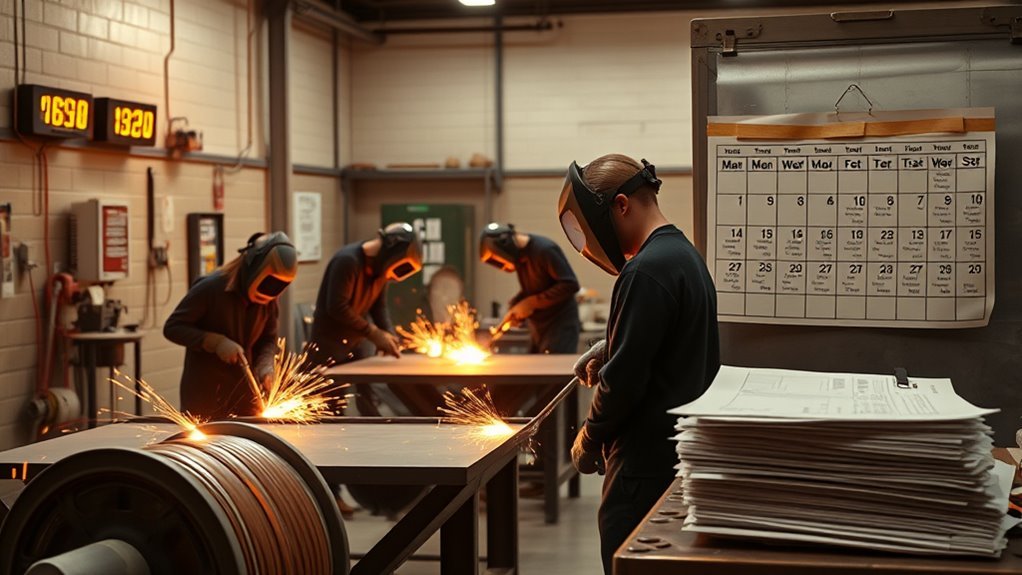If you attend a California community college you’ll typically pay about $46 per unit, so a 60‑unit AS in Welding runs roughly $2,760 in‑state and about $20,040 out‑of‑state. Shorter certificates (around 8 units) cost about $368 in‑state; specialty tracks (e.g., 30 units) about $1,380. Budget another few hundred to $1,500 for books, PPE and tools. Financial aid, scholarships, and payment plans can cut net cost — continue for details on aid, timelines, and ROI.
Estimated Tuition and Program Fees for Welding Programs in California

One clear way to budget for welding training in California is to start with per-unit rates: in-state students typically pay about $46 per unit, which makes a 60-unit AS in Welding roughly $2,760 in tuition, while out-of-state students pay about $20,040 for the same program.
You’ll see certificates (8 units) cost about $368 in-state and $2,672 out-of-state, while specialized tracks like Gas Tungsten Arc Welding (30 units) run roughly $1,380 in-state and $10,020 out-of-state.
Plan separately for books and materials—those aren’t included. Use these unit-based figures to compare programs, evaluate program accreditation, and align costs with welding industry trends such as demand for certified specialists and regional wage premiums.
Certificate, Specialty, and Associate Degree Cost Comparisons

Compare costs directly so you can choose the most efficient path: certificates run about $368 in-state (8 units) versus an A.S. at $2,760 in-state (60 units), while specialty tracks sit around $1,380 for 30 units.
Out‑of‑state rates amplify the gap—certificate ~$2,672, A.S. ~$20,040, specialty ~$10,020—affecting return on investment and time-to-entry.
You can often lower total tuition by applying prior course credit to these programs.
Certificate vs. Degree Costs
While certificates give you a faster, lower-cost entry into welding, associate degrees demand more units and a markedly higher tuition outlay: a basic Welding Certificate in California runs about $368 for in-state and $2,672 for out-of-state students for 8 units.
Specialty programs (≈30 units) cost roughly $1,380 in-state and $10,020 out-of-state, the 28‑unit automotive welding program is about $1,228 in-state and $9,352 out-of-state, and a full 60‑unit AS degree totals approximately $2,760 in-state and $20,040 out-of-state.
You’ll choose certificates if you want rapid entry to a welding job and basic industry standards compliance.
AS degrees give broader technical knowledge, more lab hours and higher credentialing potential.
Check financial aid to reduce net cost.
Specialty Program Prices
Across California’s welding pathways you’ll see clear cost tiers tied to program length and residency: you’ll pay about $368 in-state ($2,672 out-of-state) for an 8-unit certificate, ~$1,380 in-state ($10,020 out-of-state) for 30-unit specialized programs, and ~$2,760 in-state ($20,040 out-of-state) for a 60-unit associate. Specialty program advantages include focused skills that shorten time-to-certification; specialty program requirements typically demand prerequisite courses that can lower tuition if already completed. Consider Welder—Automotive at $1,228 in-state ($9,352 out-of-state) for 28 units. Compare unit counts and residency before committing.
| Program type | Typical in-state cost |
|---|---|
| Certificate (8 units) | $368 |
| Specialized (30 units) | $1,380 |
Additional Expenses: Books, Tools, and Personal Protective Equipment

Beyond tuition, you’ll need to budget for books, tools, and PPE, which can materially raise the cost of welding school in California.
You should plan for textbooks ($100–$300), PPE like helmets, gloves, jackets ($150–$500), and welding equipment/tools such as grinders and torches ($200–$1,000).
Altogether, these line items can add several hundred to over a thousand dollars to your program cost.
These extras can tack on a few hundred to more than a thousand dollars to your training.
Use budgeting tips: list required items from your program, prioritize safety-grade PPE, and compare brand vs. economy options to control upfront spend.
Buy durable tools that match program specifications to avoid replacements.
Track receipts and condition of gear—this data helps you forecast replacement cycles and total cost of ownership for training, keeping your investment predictable and industry-aligned.
Financial Aid, Scholarships, and Payment Options

If you need help covering welding school costs, financial aid, scholarships, and flexible payment plans can cut your out‑of‑pocket burden considerably.
You’ll work with school financial aid offices—for example, UTI’s office—to complete FAFSA, evaluate grants, and review loan options. Community college tuition averages about $46 per unit, and in‑state pathways or completed prerequisites can lower your total.
Scholarship opportunities vary by school, merit, demographics, and program criteria; apply early and target industry-specific awards to boost grant coverage. Ask program coordinators about institutional funds and external trade foundations.
Many schools offer installment plans or deferred payment options to smooth cash flow while you train. Compare net cost after grants and scholarships to decide the most cost‑efficient enrollment route.
Program Length and How Duration Affects Total Cost

When you compare certificate vs. Associate programs, duration drives cost—certificates can finish in about 6 months with tuition from $3,500–$20,000, while Associate degrees can take up to 4 years and reach $55,000.
Choosing full‑time, part‑time, or accelerated scheduling changes both calendar time and out‑of‑pocket expense, and residency rates (e.g., $2,760 in‑state vs. up to $20,040 out‑of‑state for a 60‑unit Associate) further shift totals.
Next we’ll quantify tradeoffs for accelerated tracks and part‑time pathways so you can match cost to timeline and work commitments.
Certificate vs. Degree
Anyone weighing a welding certificate against an A.S. degree should focus on time-to-completion, since certificates are typically finished in under two years while associate programs require about two years and 60 units of coursework; that difference drives most cost gaps—estimated tuition is roughly $368 in-state/$2,672 out-of-state for a certificate versus $2,760 in-state/$20,040 out-of-state for an A.S.—and also affects earnings potential and opportunity cost, given that certificate holders make about 20% more than those with just a high school diploma and flexible scheduling (evenings/weekends) can extend duration and raise total expenses.
You’ll pay less up front for a certificate, accelerate acquisition of core welding skills, and enter the workforce sooner. An A.S. adds broader coursework, higher tuition, and stronger positioning for career advancement or supervisory roles.
Full‑time vs. Part‑time
Because program length determines how much you pay and how quickly you can start earning, choosing full‑time versus part‑time enrollment is a financial decision as much as an academic one.
You’ll weigh full time benefits—faster completion, higher total tuition (AS: ~60 units; in‑state ~$2,760, out‑of‑state ~$20,040)—against part time flexibility that lets you work while studying and spread costs.
Certificate routes (<2 years; in‑state ~$368, out‑of‑state ~$2,672) lower entry cost and time to wage.
- Full‑time: finish sooner, pay more total tuition, enter workforce faster.
- Part‑time: extend duration, risk higher cumulative fees per unit.
- Work offset: part‑time schedules (evening/weekend/online) enable earned income to reduce net cost.
- Certificate: lowest cost-to-complete for quick entry.
Accelerated Programs
If you need to get into the shop faster than a two‑year AS program allows, accelerated welding tracks squeeze core skills into roughly 9–10 months so you can start earning sooner and lower total tuition exposure.
You’ll benefit from accelerated learning that concentrates hands‑on labs and code‑based instruction into compact semesters, reducing living and tuition costs versus multi‑year degrees.
Certificate options often finish in under two years; a Certificate of Specialization example costs about $368 for 8 units in‑state, versus an AS degree estimated at $2,760 in‑state and $20,040 out‑of‑state.
Program benefits include faster credentialing, earlier entry to paid apprenticeships, and flexible evening/weekend or online modules to balance work and slice expenses through part‑time study.
Choose duration by wage trade‑off and budget.
Career Outlook and Expected Earnings After Graduation
When you complete a welding program in California, you’ll enter a job market with steady demand and measurable pay gains: the BLS projects over 45,800 U.S. openings from 2023–2033.
Certificate-holders typically earn about 20% more than high-school-only workers, and median wages sit near $51,000 nationally (with entry roles in some states around $45,340 and skilled hourly rates like $23.97 in North Carolina).
While industry sectors such as aerospace, construction, and manufacturing offer premium pay for specialized skills, you’ll benefit from clear industry trends and often higher job satisfaction when you pair credentials with specialization.
Expect faster wage growth with experience and certifications.
Typical outcomes include:
- Entry-level welder positions with baseline pay and on-the-job training.
- Certified welders earning ~20% more.
- Specialized trades in aerospace/manufacturing with premium salaries.
- Hourly, contract, and union roles varying by region.
How to Choose the Right Welding Program for Your Budget
After reviewing job prospects and pay, you’ll want to match program cost and credentials to your career goals.
Start by comparing tuition: certificate programs average $368 in-state vs $2,672 out-of-state for 8 units; AS degrees are roughly $2,760 in-state vs $20,040 out-of-state for 60 units.
Compare tuition carefully: certificates cost about $368 in-state vs $2,672 out-of-state (8 units); AS degrees about $2,760 vs $20,040 (60 units).
Specialized tracks (e.g., GTAW) run about $1,380 in-state vs $10,020 out-of-state for 30 units.
Factor program length, evening/online options, and credential relevance to desired roles.
Use financial planning: assess grants, scholarships, loans, and in-district rates at welding schools to minimize net cost.
Prioritize programs with hands-on hours and industry certifications that align with pay differentials to maximize return on investment.
Frequently Asked Questions
Can I Get Credit for Prior Welding Experience?
Yes — you can often get credit for prior welding experience; schools evaluate your skills via tests or portfolio review, then approve credit transfer toward certification or coursework, reducing time and cost based on demonstrated competency and documented experience.
Do Welding Schools Offer Night or Weekend Classes?
Yes — you’ll find night classes and weekend programs. They’re designed like shift schedules, aligning training hours with workforce demand; many schools offer modular cohorts, evening labs, and quantified contact hours to fit working professionals’ timelines.
Are Apprenticeship Placements Guaranteed After Graduation?
No, apprenticeship placements aren’t guaranteed after graduation; you’ll get apprenticeship opportunities and job placement support from many programs, but acceptance depends on employer demand, your weld test scores, certifications, and local labor market conditions.
What Safety Certifications Are Included in the Curriculum?
You’ll earn OSHA 10 and hot work certifications, plus hands-on safety protocols training, EPA and confined-space awareness, and industry-standard certification types like AWS entry-level credentials; labs and simulated jobsite drills reinforce measurable competency.
Can I Rent or Lease Welding Equipment From the School?
Yes — you can rent or lease welding equipment from many schools; rental options vary by program, duration, and cost, and the school handles equipment maintenance, inspections, and replacement to meet safety and training standards.
Conclusion
You’ll often find that tuition for welding programs in California lines up with the job market: higher-cost, longer associate degrees tend to connect with higher starting wages, while shorter certificates get you into the field faster with lower upfront spending. Coincidentally, the programs that cost a bit more usually include better equipment and employer partnerships, boosting placement rates. Weigh total cost, duration, and projected earnings to pick the most cost-effective path.


